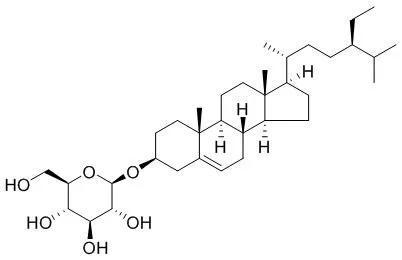| Description: |
Daucosterol has neuroprotective activity, it has proliferation-enhancing activity for neural stem cells (NSCs), may be involved in IGF1-AKT pathway, and it as an efficient and inexpensive growth factor alternative that could be potentially developed as a medicine for ischemic stroke treatment, can significantly reduce neuronal loss.Daucosterol exhibits moderate antibacterial activity against Bacillus subtilis and Staphylococcus aureus; it has anti-cancer and apoptotic effects in human colon cancer cell line HCT-116, at different doses induces cell cycle arrest at sub-G1 phase of the cell cycle. |
| In vitro: |
| J Steroid Biochem Mol Biol. 2014 Mar;140:90-9. | | Daucosterol promotes the proliferation of neural stem cells.[Pubmed: 24333794] | Neural stem cells (NSCs) are self-regenerating cells, but their regenerative capacity is limited.
METHODS AND RESULTS:
The present study was conducted to investigate the effect of Daucosterol (a sterolin) on the promotion of NSC proliferation and determine the corresponding molecular mechanism. Results of cell counting kit-8 (CCK-8) assay showed that Daucosterol significantly increased the quantity of viable cells and the effectiveness of Daucosterol was similar to that of basic fibroblast growth factor (bFGF) and epidermal growth factor (EGF). Flow cytometry detection of CFSE-labeled (CFSE, carboxyfluorescein diacetate succinimidyl ester) NSCs showed that Div Index (or the average number of cell divisions) and % Divided (or the percentage of cells that divided at least once) of the cells were increased, indicating that Daucosterol increased the percentage of NSCs re-entering the cell cycle. mRNA microarray analysis showed that 333 genes that are mostly involved in the mitotic cell cycle were up-regulated. By contrast, 627 genes that are mostly involved in differentiation were down-regulated. In particular, insulin-like growth factor I (IGF1) was considered as an important regulatory gene that functionally promoted NSC proliferation, and the increased expression of IGF1 protein was validated by ELISA. In addition, the phosphorylation of AKT was increased, indicating that the proliferation-enhancing activity of Daucosterol may be involved in IGF1-AKT pathway.
CONCLUSIONS:
Our study provided information about Daucosterol as an efficient and inexpensive growth factor alternative that could be used in clinical medicine and research applications. | | J Steroid Biochem Mol Biol. 2015 Apr 9;152:45-52. | | Daucosterol protects neurons against oxygen-glucose deprivation/reperfusion-mediated injury by activating IGF1 signaling pathway.[Pubmed: 25864625] | We previously reported that Daucosterol (a sterolin) up-regulates the expression of insulin-like growth factor I (IGF1)(1) protein in neural stem cells.
METHODS AND RESULTS:
In this study, we investigated the effects of Daucosterol on the survival of cultured cortical neurons after neurons were subjected to oxygen and glucose deprivation and simulated reperfusion (OGD/R)(2), and determined the corresponding molecular mechanism. The results showed that post-treatment of Daucosterol significantly reduced neuronal loss, as well as apoptotic rate and caspase-3 activity, displaying the neuroprotective activity. We also found that Daucosterol increased the expression level of IGF1 protein, diminished the down-regulation of p-AKT(3) and p-GSK-3β(4), thus activating the AKT(5) signal pathway. Additionally, it diminished the down-regulation of the anti-apoptotic proteins Mcl-1(6) and Bcl-2(7), and decreased the expression level of the pro-apoptotic protein Bax(8), thus raising the ratio of Bcl-2/Bax. The neuroprotective effect of Daucosterol was inhibited in the presence of picropodophyllin (PPP)(9), the inhibitor of insulin-like growth factor I receptors (IGF1R)(10).
CONCLUSIONS:
Our study provided information about Daucosterol as an efficient and inexpensive neuroprotectants, to which the IGF1-like activity of Daucosterol contributes. Daucosterol could be potentially developed as a medicine for ischemic stroke treatment. | | Nat Prod Res. 2007 Aug;21(10):889-96. | | A novel daucosterol derivative and antibacterial activity of compounds from Arctotis arctotoides.[Pubmed: 17680499] | Arctotis arctotoides is a perennial herb used medicinally for the treatment of various ailments in the Eastern Cape, South Africa. Different extracts of the plant were investigated for their antimicrobial constituents.
METHODS AND RESULTS:
This led to the isolation and identification of a new Daucosterol derivative 3-O-[beta-D-(6'-nonadeanoate)glucopyranosyl]-beta-sitosterol and seven known compounds namely: serratagenic acid, stigmasterol, Daucosterol, zaluzanin D, dehydrocostuslactone, nepetin, and pedalitin. The structures of the compounds were elucidated on the basis of spectral analysis, including homo and hetero nuclear correlation NMR experiments (COSY, NOESY, HMQC, HMBC) and mass spectra as well as by comparison with available data in the literature. The compounds exhibited antibacterial activity except stigmasterol, Daucosterol and dehydrocostuslactone.
CONCLUSIONS:
Nepetin was the most active against Bacillus subtilis and Staphylococcus aureus with the minimum inhibitory concentrations of 4 microg mL( - 1) and 31 microg mL( - 1), respectively, while others exhibited moderate activity. |
|
| In vivo: |
| Vaccine. 2007 May 10;25(19):3834-40. | | Immunoregulatory activity by daucosterol, a beta-sitosterol glycoside, induces protective Th1 immune response against disseminated Candidiasis in mice.[Pubmed: 17335944 ] |
METHODS AND RESULTS:
In the present study, we investigated immunomodulatory effect of Daucosterol, a beta-sitosterol glycoside, against disseminated candidiasis caused by Candida albicans. Results showed that direct interaction of Daucosterol with C. albicans yeast cells resulted in no growth-inhibition by in vitro susceptibility analysis. In contrast, mice given Daucosterol (DS) intraperitoneally before intravenous challenge with live C. albicans yeast cells survived longer than DS-untreated control mice against disseminated candidiasis (P<0.05). By assessment of the fungal CFU in kidneys, DS-treated mice before the challenge developed about 81% fewer kidney CFU than untreated controls. This protection was removable by pretreatment of mice with anti-CD4+ antibody before the DS-treatment and challenge with the yeast. However, the protection was transferable by the CD4+ T cells from DS-treated mice not infected with the yeast. ELISA analysis revealed there were predominant production of IFNgamma and IL-2 cytokines as compared to IL-4, and IL-10 productions in DS-treated mice. By treatment of DS-given mice with anti-mouse IFNgamma, the protection was also abolished.
CONCLUSIONS:
Our studies show that DS protects mice against disseminated candidiasis by the CD4+ Th1 immune response. |
|






 Cell. 2018 Jan 11;172(1-2):249-261.e12. doi: 10.1016/j.cell.2017.12.019.IF=36.216(2019)
Cell. 2018 Jan 11;172(1-2):249-261.e12. doi: 10.1016/j.cell.2017.12.019.IF=36.216(2019) Cell Metab. 2020 Mar 3;31(3):534-548.e5. doi: 10.1016/j.cmet.2020.01.002.IF=22.415(2019)
Cell Metab. 2020 Mar 3;31(3):534-548.e5. doi: 10.1016/j.cmet.2020.01.002.IF=22.415(2019) Mol Cell. 2017 Nov 16;68(4):673-685.e6. doi: 10.1016/j.molcel.2017.10.022.IF=14.548(2019)
Mol Cell. 2017 Nov 16;68(4):673-685.e6. doi: 10.1016/j.molcel.2017.10.022.IF=14.548(2019)